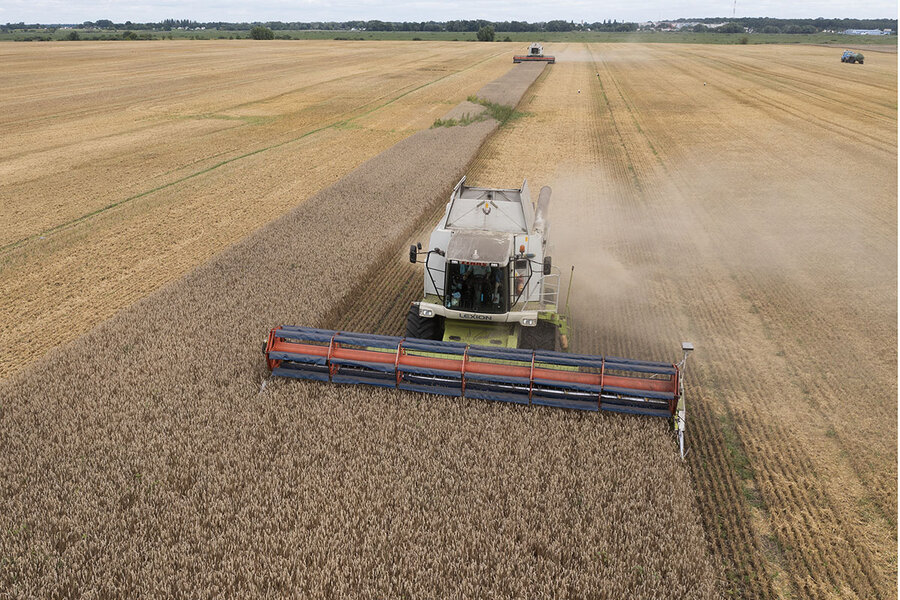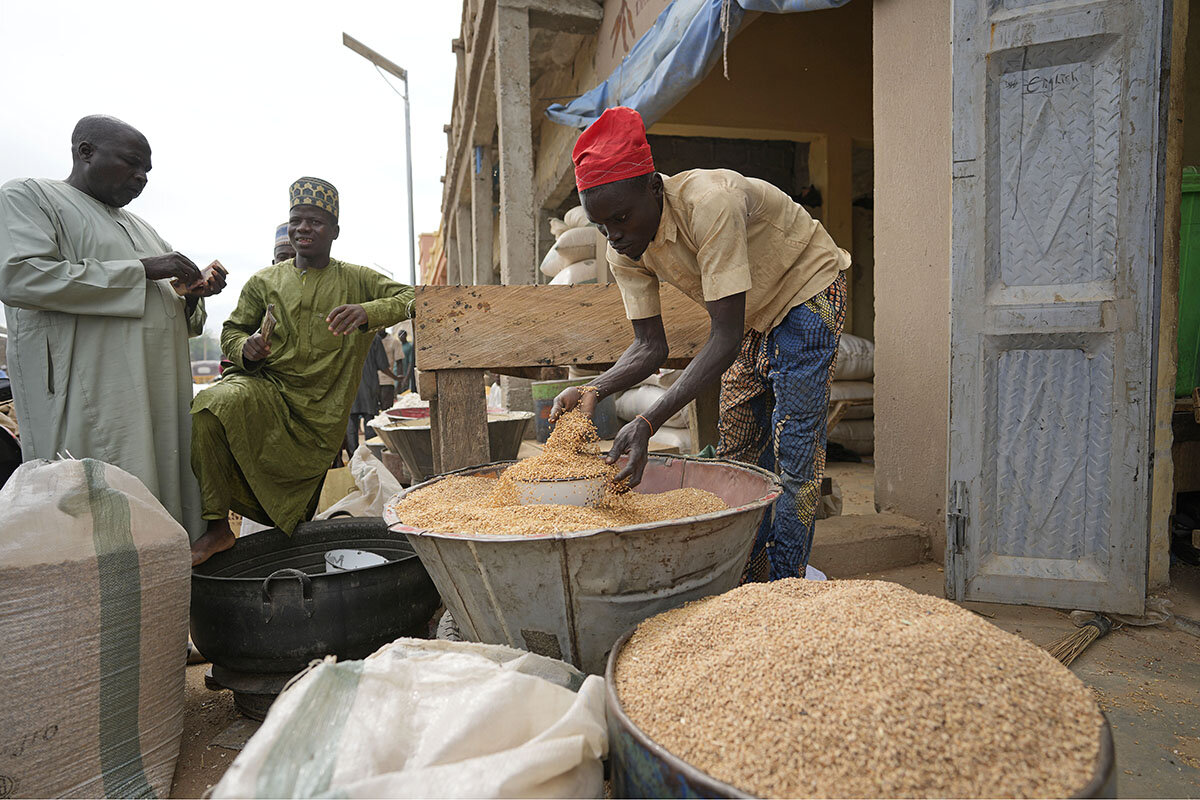How world averted a grain shortage, despite Ukraine war
Loading...
The world’s food exporters are producing enough grain to avoid the shortages predicted last year with the outbreak of war between major farming nations Russia and Ukraine.
That’s welcome news to consumers globally at a time of high inflation, including for food prices.
Why We Wrote This
A story focused onDespite dire predictions of food shortages, global wheat prices are falling and other grains are in solid supply. While food insecurity remains, the progress is a sign of the farm sector’s resilience.
Surprisingly, the change is largely due to Russia’s excellent wheat harvest and Ukrainian pluck. The U.S. Department of Agriculture estimated Thursday the Russian wheat harvest at a record 92 million metric tons, up more than 20% from last year. Even more surprising is Ukraine, where farmers have managed to match last year’s production, the agency estimates.
Still, an estimated 238 million people in 48 nations face high levels of acute food insecurity. The reasons include conflict and crop prices that remain too high for some poor nations to afford.
Ukrainian farmers still face challenges with processing and transportation that, by undercutting profits, put their future output at risk. But overall, the global agricultural system has repeatedly adjusted to shocks.
“Globally, there are no shortages,” says Monika Tothova, a Rome-based economist with the U.N. Food and Agriculture Organization. “The problem is that the price is high and the countries in need might be having difficult times accessing it.”
The world’s food exporters are producing enough grain to avoid the shortages predicted last year with the outbreak of war between major farming nations Russia and Ukraine.
That’s welcome news to consumers globally at a time of high inflation, including for food prices.
Global supply and demand for corn and soybeans are in balance, by and large. In place of last year’s panic over rising prices, global wheat prices are falling.
Why We Wrote This
A story focused onDespite dire predictions of food shortages, global wheat prices are falling and other grains are in solid supply. While food insecurity remains, the progress is a sign of the farm sector’s resilience.
“So far, things have worked much, much better than I think people projected,” says Allen Featherstone, head of agricultural economics at Kansas State University in Manhattan, Kansas. But “there’s still a lot of instability there.”
Surprisingly, the change is largely due to Russia’s excellent wheat harvest and Ukrainian pluck. The U.S. Department of Agriculture estimated Thursday the Russian wheat harvest at a record 92 million metric tons, up more than 20% from last year. Even more surprising is Ukraine, where despite the ravages of war and missile attacks, farmers have still managed to match last year’s production, the agency estimates. And their combined exports will reach record highs this year and remain nearly as high next year, forecasts AgResource Co.
“The upshot is that Black Sea wheat exports will be near record large in 2023/24,” Dan Basse, president of the Chicago-based agricultural research firm, writes in an email. By next year, the war in Ukraine will have “virtually no impact with wheat prices at a three-year low.”
The generally rosy scenario has been helped by strong harvests of corn and soybeans elsewhere in the world.
Problems remain, however.
In July, India banned exports of its biggest category of rice, sending world rice prices spiraling up. The appearance of an El Niño weather pattern could portend dry conditions for Southern Hemisphere farmers planting their new crops. And the war in Ukraine could cause new problems if it drags on.
One of the ironies is that despite the relatively positive global crop situation, the world’s push to reduce food insecurity has stalled. As of August, nearly 238 million people in 48 nations faced high levels of acute food insecurity, the Joint Research Centre of the European Commission reported. That amounts to almost 1 in 5 people in those nations, which was similar to 2022.
One reason is that crop prices are still too high for some poor nations to afford.
“Globally, there are no shortages,” says Monika Tothova, a Rome-based economist with the United Nations’ Food and Agriculture Organization. “The problem is that the price is high and the countries in need might be having difficult times accessing it.”
Another driver is conflict. East Africa’s food crisis, the world’s worst, intensified this year with civil war in Sudan pushing 8 million more people into high levels of acute food insecurity. The new Hamas-Israeli conflict is also likely to intensify an already difficult situation in Palestinian Gaza. Israel has cut off food shipments to the enclave, where nearly two-thirds of the population was food-insecure even before the latest outbreak of violence, according to the U.N. World Food Program.
And the war in Ukraine could once again darken the food outlook, unless Ukrainian farmers can find ways to boost revenues and cut costs. For example: A major exporter of wheat, Ukraine in normal times is also a big corn producer and the world’s biggest exporter of sunflower oil (used for cooking) and meal (used to feed livestock). Now the nation often doesn’t have the electric power to dry its corn or crush its sunflowers into meal and oil, points out Antonina Broyaka, a Ukrainian agricultural economist who fled the country with her children early in the war and now works at Kansas State University. So many have shifted out of corn into sunflowers, a lower-value crop.
Rising transportation costs pose another huge challenge. In July, Russia pulled out of a deal that allowed Ukraine to export grain via the Black Sea, forcing Kyiv to find new, costlier ways to move its grain abroad, which has cut into farmers’ profits.
“The production is not profitable at all, and it’s getting harder and harder for farmers to keep the agriculture moving ... because they don’t have enough money for inputs, for seeds, for fertilizers,” says Ms. Broyaka. If the situation doesn’t change, planted acreage could dwindle over the next several years, she adds.
Time and again, the global agricultural system has adjusted to shocks. “It’s kind of like a kid. You stumble on the sidewalk and you skin your knee,” says Stephen Nicholson, a global strategist for grains and oilseeds at Rabobank, an agribusiness bank. “But you pick yourself back up and you move on.”









